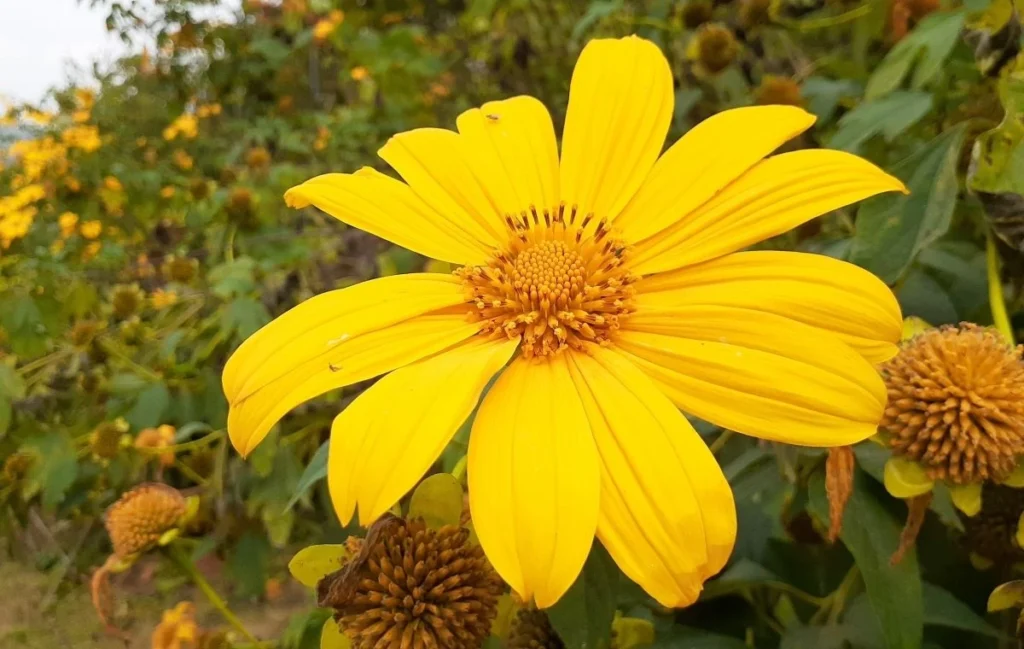The Mexican Sunflower, of the species Tithonia diversifolia, is a plant native to Mexico, Central America, and the Caribbean, with a semi-herbaceous texture and shrubby stature that stands out worldwide for its ornamental flowering, medicinal applications, as fodder, and even as green manure. This plant grows in an erect, vigorous, and branched manner, reaching heights ranging from 4.9 to 13.1 feet (1.5 to 4 meters). Its branches are robust and grow quickly, yet they are somewhat brittle, not tolerating much handling or strong winds. They are herbaceous when young and gradually become woody from the base. Its leaves can be entire or lobed, are alternate, serrated, and present a pubescent texture.
The Mexican Sunflower produces remarkable inflorescences, which can be found both at the tips and in the leaf axils. Its flowers are a vivid and intense yellow to orange, and they group together in large, solitary capitula, closely resembling traditional sunflowers. These stunning flowers generally bloom abundantly during the autumn, winter, and spring months. Throughout the flowering period, the Mexican sunflower attracts many pollinators, such as bees and butterflies, with its honey-like aroma. The fruits that follow are of the achene type.

If you are planning a large-scale garden in a tropical climate region, consider adding the Mexican Sunflower. Its stunning flowers and lush appearance will surely enrich your outdoor space. It is also a great option along roads and pathways, in the form of hedges. Due to its rapid growth, it is interesting for new gardens, in areas that have been devoid of vegetation. In a short time, it is possible to create a stunning effect with a profusion of flowers.
As it reaches large sizes, its informal hedges can be useful for visually blocking certain areas of the garden, as well as for blocking air and noise pollution from highways or factories. Besides the rapid effect in the garden, it is an excellent green manure. The branches resulting from pruning can be shredded and left on the beds as a potent fertilizer, both for its high nutrient content and for the addition of a consistent source of organic matter, with an excellent carbon/nitrogen ratio.
The Mexican Sunflower thrives when planted in sunny locations and in fertile soil, as long as it is properly irrigated during the dry period. The well-established plant without irrigation may not die, but will look stressed, with sparse and scorched leaves. Moreover, due to its vigorous growth, drastic pruning is recommended right after flowering, stimulating a more rounded and dense aspect of the plant, and reducing its height.
It is important to mention that the Mexican Sunflower is a hardy plant, but does not tolerate low temperatures well. Therefore, it is more suitable for regions with tropical and equatorial climates. It does not withstand the frosts of subtropical to temperate areas, which will leave its foliage quite damaged. However, depending on the damage, a good pruning can recover it and stimulate new sprouts. Moreover, its use as an annual plant is quite interesting, renewing the beds with replanting of new seedlings, produced in the nursery, during spring. It adapts very well to coastal regions.
Propagation of this plant is easily done from seeds, which tend to germinate naturally and form seedlings close to the mother plant. This characteristic facilitates its multiplication and makes the Mexican Sunflower an excellent choice for those who wish to grow a beautiful ornamental plant. For the same reason, this species can become invasive in some situations. But note that right after harvesting, the seeds do not have a good germination rate, which reaches its peak only 4 months after harvest, when it becomes the ideal time to sow them. Another very simple way to multiply the Mexican sunflower is by cuttings. Cut cuttings from the middle third of the green branches, about 11.8 inches (30 cm) in length, and plant in light substrate kept moist. The plant’s rooting is fast, and in a few days, sprouts can be observed.


